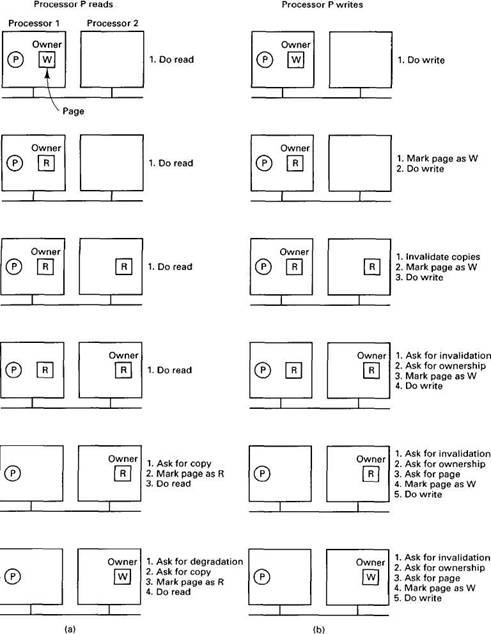Книга: Distributed operating systems
6.4.5. Finding the Owner
6.4.5. Finding the Owner
We glossed over a few points in the description above. One of them is how to find the owner of the page. The simplest solution is by doing a broadcast, asking for the owner of the specified page to respond. Once the owner has been located this way, the protocol can proceed as above.
An obvious optimization is not just to ask who the owner is, but also to tell whether the sender wants to read or write and say whether it needs a copy of the page. The owner can then send a single message transferring ownership and the page as well, if needed.

Fig. 6-27. (a) Process P wants to read a page. (b) Process P wants to write a page.
Broadcasting has the disadvantage of interrupting each processor, forcing it to inspect the request packet. For all the processors except the owner's, handling the interrupt is essentially wasted time. Broadcasting may use up considerable network bandwidth, depending on the hardware.
Li and Hudak (1989) describe several other possibilities as well. In the first of these, one process is designated as the page manager. It is the job of the manager to keep track of who owns each page. When a process, P, wants to read a page it does not have or wants to write a page it does not own, it sends a message to the page manager telling which operation it wants to perform and on which page. The manager then sends back a message telling who the owner is. P now contacts the owner to get the page and/or the ownership, as required. Four messages are needed for this protocol, as illustrated in Fig. 6-28(a).

Fig. 6-28. Ownership location using a central manager. (a) Four-message protocol. (b) Three-message protocol.
An optimization of this ownership location protocol is shown in Fig. 6-28(b). Here the page manager forwards the request directly to the owner, which then replies directly back to P, saving one message.
A problem with this protocol is the potentially heavy load on the page manager, handling all the incoming requests. This problem can be reduced by having multiple page managers instead of just one. Splitting the work over multiple managers introduces a new problem, however — finding the right manager. A simple solution is to use the low-order bits of the page number as an index into a table of managers. Thus with eight page managers, all pages that end with 000 are handled by manager 0, all pages that end with 001 are handled by manager 1, and so on. A different mapping, for example by using a hash function, is also possible. The page manager uses the incoming requests not only to provide replies but also to keep track of changes in ownership. When a process says that it wants to write on a page, the manager records that process as the new owner.
Still another possible algorithm is having each process (or more likely, each processor) keep track of the probable owner of each page. Requests for ownership are sent to the probable owner, which forwards them if ownership has changed. If ownership has changed several times, the request message will also have to be forwarded several times. At the start of execution and every n times ownership changes, the location of the new owner should be broadcast, to allow all processors to update their tables of probable owners.
The problem of locating the manager also is present in multiprocessors, such as Dash, and also in Memnet. In both of these systems it is solved by dividing the address space into regions and assigning each region to a fixed manager, essentially the same technique as the multiple-manager solution discussed above, but using the high-order bits of the page number as the manager number.
- 6.4.6. Finding the Copies
- 4.4.4 The Dispatcher
- About the author
- Chapter 7. The state machine
- Appendix E. Other resources and links
- Example NAT machine in theory
- The final stage of our NAT machine
- Compiling the user-land applications
- The conntrack entries
- Untracked connections and the raw table
- Basics of the iptables command
- Owner match




